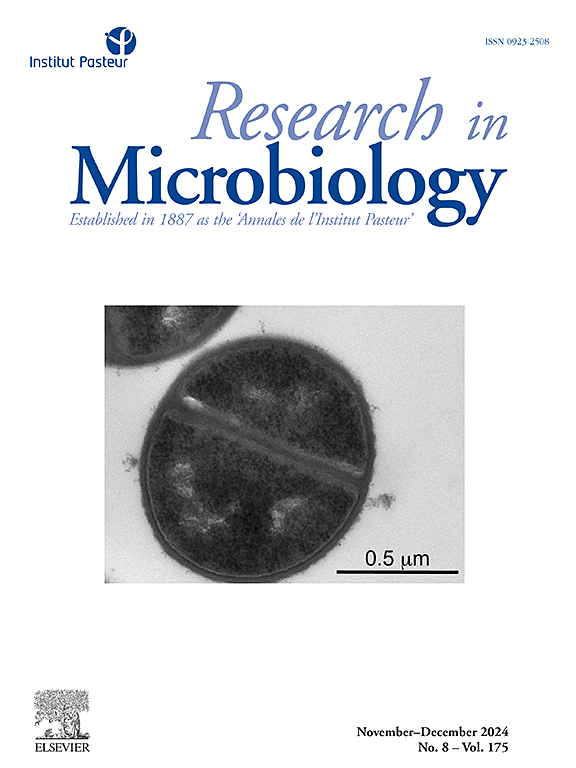Antimicrobial resistance in coagulase negative staphylococci: Genome analysis and role of horizontal gene transfer
IF 3.4
4区 生物学
Q3 MICROBIOLOGY
引用次数: 0
Abstract
Coagulase-negative staphylococci (CNS) are emerging as significant contributors to antimicrobial resistance, yet their genomic characteristics remain incompletely understood. This study presents a whole-genome analysis of 12 multidrug-resistant CNS strains (Staphylococcus epidermidis, Staphylococcus haemolyticus, Staphylococcus hominis) isolated from blood cultures, focusing on antimicrobial resistance genes, mobile genetic elements (MGEs), and horizontal gene transfer (HGT) mechanisms.
We identified 22 resistance genes conferring resistance to 11 antimicrobial classes, many of which were plasmid-associated. Notably, we report the first detection of the ISSha1 insertion sequence in S. hominis, along with novel resistance plasmids, including pGO1 and VRSAp in S. haemolyticus and pAMα1 in S. hominis. The identification of bacteriophage-derived sequences in S. haemolyticus and S. hominis suggests a role for phages in genetic exchange. CRISPR sequences and a Cas gene were detected in S. hominis, suggesting a potential but unconfirmed role in restricting gene transfer. Additionally, pGO1 was identified as a conjugative plasmid, while pAMα1 and VRSAp were determined to be mobilizable, reinforcing the role of CNS in resistance dissemination.
These results highlight CNS as reservoirs of antimicrobial resistance genes and emphasize the importance of species-specific genomic surveillance. Proactive monitoring of CNS is crucial for controlling antimicrobial resistance in clinical settings.
凝固酶阴性葡萄球菌的抗菌素耐药性:基因组分析和水平基因转移的作用。
凝固酶阴性葡萄球菌(CNS)正在成为抗菌素耐药性的重要贡献者,但其基因组特征仍不完全清楚。本研究对从血液培养中分离的12株多重耐药CNS菌株(表皮葡萄球菌、溶血葡萄球菌、人型葡萄球菌)进行了全基因组分析,重点研究了耐药基因、移动遗传元件(MGEs)和水平基因转移(HGT)机制。我们鉴定出22个耐药基因,对11种抗菌素具有耐药性,其中许多是质粒相关的。值得注意的是,我们报告了首次在人链球菌中检测到ISSha1插入序列,以及新的耐药质粒,包括溶血链球菌的pGO1和VRSAp,以及人链球菌的pAMα1。溶血链球菌和人血链球菌中噬菌体衍生序列的鉴定表明噬菌体在遗传交换中的作用。在S. hominis中检测到CRISPR序列和一个Cas基因,提示在限制基因转移方面有潜在但未证实的作用。此外,pGO1被鉴定为共轭质粒,而pAMα1和VRSAp被确定为可动员质粒,加强了CNS在抗性传播中的作用。这些结果突出了中枢神经系统作为抗菌素耐药基因的储存库,并强调了物种特异性基因组监测的重要性。主动监测中枢神经系统对于控制临床环境中的抗菌素耐药性至关重要。
本文章由计算机程序翻译,如有差异,请以英文原文为准。
求助全文
约1分钟内获得全文
求助全文
来源期刊

Research in microbiology
生物-微生物学
CiteScore
4.10
自引率
3.80%
发文量
54
审稿时长
16 days
期刊介绍:
Research in Microbiology is the direct descendant of the original Pasteur periodical entitled Annales de l''Institut Pasteur, created in 1887 by Emile Duclaux under the patronage of Louis Pasteur. The Editorial Committee included Chamberland, Grancher, Nocard, Roux and Straus, and the first issue began with Louis Pasteur''s "Lettre sur la Rage" which clearly defines the spirit of the journal:"You have informed me, my dear Duclaux, that you intend to start a monthly collection of articles entitled "Annales de l''Institut Pasteur". You will be rendering a service that will be appreciated by the ever increasing number of young scientists who are attracted to microbiological studies. In your Annales, our laboratory research will of course occupy a central position, but the work from outside groups that you intend to publish will be a source of competitive stimulation for all of us."That first volume included 53 articles as well as critical reviews and book reviews. From that time on, the Annales appeared regularly every month, without interruption, even during the two world wars. Although the journal has undergone many changes over the past 100 years (in the title, the format, the language) reflecting the evolution in scientific publishing, it has consistently maintained the Pasteur tradition by publishing original reports on all aspects of microbiology.
 求助内容:
求助内容: 应助结果提醒方式:
应助结果提醒方式:


